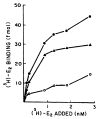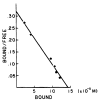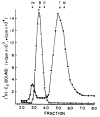Estrogen binding protein activity in Morris hepatoma 7777 compared with normal rat liver
- PMID: 6201412
- PMCID: PMC2963457
Estrogen binding protein activity in Morris hepatoma 7777 compared with normal rat liver
Abstract
Estrogen binding protein activities were determined in the cytosol from adult male Buffalo rat liver and Morris hepatoma 7777. Estrogen receptors were prepared using the protamine sulfate precipitation technique of Chamness. The ability of various unlabeled steroids competing with [3H]estradiol was examined to establish the binding specificity. Estradiol binding in Morris hepatoma 7777 cytosol was greatly decreased compared with that present in hepatic cytosol prepared from normal rat liver. The receptor concentration expressed as femtomoles per milligram of cytoplasmic protein was 31.1 +/- 2.9 SD for normal rat liver and 0.41 +/- 0.88 SD for the hepatoma. Gel filtration chromatography revealed the presence of an estrogen binder in hepatoma cytosol which was not present in either normal liver or in the protamine sulfate precipitates of hepatoma cytosol. The molecular weight, binding specificity, and precipitation of this protein by specific antiserum suggests that it is alpha-fetoprotein.
Figures






Similar articles
-
Characterization and quantitation of human hepatic estrogen receptor.Gastroenterology. 1983 Apr;84(4):704-12. Gastroenterology. 1983. PMID: 6825981
-
Purification and partial characterization of protein 35/7.7 a cytosol protein that is abundant in rapidly growing hepatomas.Cell Biol Int Rep. 1978 Sep;2(5):447-56. doi: 10.1016/0309-1651(78)90096-6. Cell Biol Int Rep. 1978. PMID: 709606
-
A micro-assay for estrogen receptor in breast tumor with use of 125I-labeled estradiol.Clin Chem. 1982 Jun;28(6):1303-8. Clin Chem. 1982. PMID: 7074937
-
Purification and characterization of cytosol protein 45/7.8 present in rapidly growing hepatomas.Cancer Res. 1980 May;40(5):1623-9. Cancer Res. 1980. PMID: 7370994
-
Estrogen and antiestrogen binding to rat uterine and pituitary estrogen receptor: evidence for at least two physicochemical forms of the estrogen receptor.J Steroid Biochem. 1985 Nov;23(5A):537-45. doi: 10.1016/0022-4731(85)90001-9. J Steroid Biochem. 1985. PMID: 4079371
Cited by
-
Estrogen receptors in hepatocellular carcinoma: is endocrine therapy for hepatocellular carcinoma likely to be effective?Gastroenterol Jpn. 1987 Jun;22(3):322-30. doi: 10.1007/BF02774258. Gastroenterol Jpn. 1987. PMID: 3040510
-
Regenerating rat liver: correlations between estrogen receptor localization and deoxyribonucleic acid synthesis.Gastroenterology. 1984 Mar;86(3):552-7. Gastroenterology. 1984. PMID: 6693017 Free PMC article.
References
-
- Corvol PL, Chrambach A, Rodbard D, et al. Physical properties and binding capacity of testosterone-binding globulin in human plasma determined by polyacrylamide electrophoresis. J Biol Chem. 1971;246:3435–43. - PubMed
-
- Laragh JH, Bauer L, Brunner HR, et al. Renin angiotensin and aldosterone system in pathogenesis and management of hypertensive vascular disease. Am J Med. 1972;52:633–52. - PubMed
-
- Menard J, Corvol P, Foliot A, et al. Effects of estrogens on renin substrate and uterine weights in rats. Endocrinology. 1973;93:747–51. - PubMed
-
- Song CS, Rifkind AB, Gillete PN, et al. The effect of estrogens, progestins and pregnancy on hepatic function. Am J Obstet Gynecol. 1969;105:813–47. - PubMed
-
- Eisenfeld AJ, Aten RF, Weinberger M, et al. Estrogen receptor in the mammalian liver. Science. 1976;191:862–5. - PubMed
Publication types
MeSH terms
Substances
Grants and funding
LinkOut - more resources
Full Text Sources

